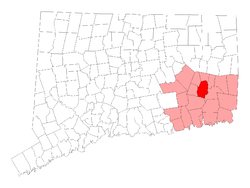Norwich, CT
| Norwich, Connecticut | ||
|---|---|---|
| City | ||

A view of the Norwich City Hall
|
||
|
||
| Nickname(s): The Rose Of New England | ||
 Location in New London County, Connecticut |
||
| Coordinates: 41°33′01″N 72°05′15″W / 41.55028°N 72.08750°WCoordinates: 41°33′01″N 72°05′15″W / 41.55028°N 72.08750°W | ||
| Country | United States | |
| State | Connecticut | |
| NECTA | Norwich-New London | |
| Region | Southeastern Connecticut | |
| Settled | 1659 | |
| Incorporated (city) | 1784 | |
| Consolidated | 1952 | |
| Government | ||
| • Type | Council-manager | |
| • City council |
|
|
| • City manager | John Bilda | |
| Area | ||
| • City | 29.5 sq mi (76.4 km2) | |
| • Land | 28.3 sq mi (73.4 km2) | |
| • Water | 1.1 sq mi (3.0 km2) | |
| • Urban | 123.1 sq mi (318.7 km2) | |
| Elevation | 56 ft (17 m) | |
| Population (2010) | ||
| • City | 40,493 | |
| • Estimate (2016) | 39,556 | |
| • Density | 1,290/sq mi (499/km2) | |
| • Metro | 274,055 | |
| Time zone | Eastern (UTC−5) | |
| • Summer (DST) | Eastern (UTC−4) | |
| ZIP code | 06360, 06365, 06380 | |
| Area code(s) | 860 | |
| FIPS code | 09-56200 | |
| GNIS feature ID | 0209410 | |
| Website | http://www.norwichct.org/ | |
Norwich, known as 'The Rose of New England', is a city in New London County, Connecticut, United States. The population was 40,493 at the 2010 United States Census. Three rivers, the Yantic, the Shetucket, and the Quinebaug, flow into the city and form its harbor, from which the Thames River flows south to Long Island Sound.
Norwichtown was founded in 1659, by settlers from Old Saybrook led by Major John Mason and Reverend James Fitch. They purchased the land "nine miles square" that would become Norwich from the local Native Mohegan Sachem Uncas. In 1668, a wharf was established at Yantic Cove. Settlement was primarily in the three-mile (5-km) area around the Norwichtown Green. The 69 founding families soon divided up the land in the Norwichtown vicinity for farms and businesses.
By 1694, the public landing built at the head of the Thames River allowed ships to offload goods at the harbor; the harbor area is known as the Chelsea neighborhood. The distance between the port and Norwichtown was serviced by the East and West Roads, which later became Washington Street and Broadway.
The original center of the town was a neighborhood now called Norwichtown, an inland location chosen to be the center of a primarily agricultural farming community. By the latter 18th century, shipping at the harbor began to become far more important than farming, especially when industrial mills began manufacturing on the three smaller rivers.
By the early 19th century, the center of Norwich had effectively moved to the Chelsea neighborhood. The official buildings of the city were located in the harbor area, such as the City Hall, courts, and post office, and all the large 19th-century urban blocks. The former center is now called Norwichtown to distinguish it from the current city.
Norwich merchants were shipping goods directly from England, but the Stamp Act of 1764 forced Norwich to become more self-sufficient. Soon large mills and factories sprang up at the falls on the rivers which traverse the town. The ship captains of Norwich and New London who were skillful at avoiding Imperial taxation during peacetime later were just as successful eluding warships during war.
...
Wikipedia

